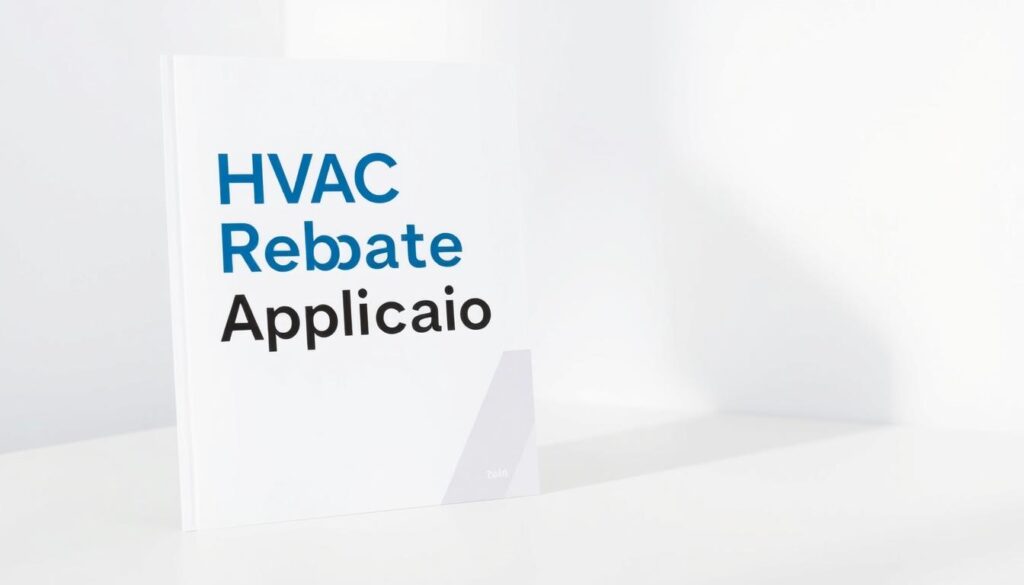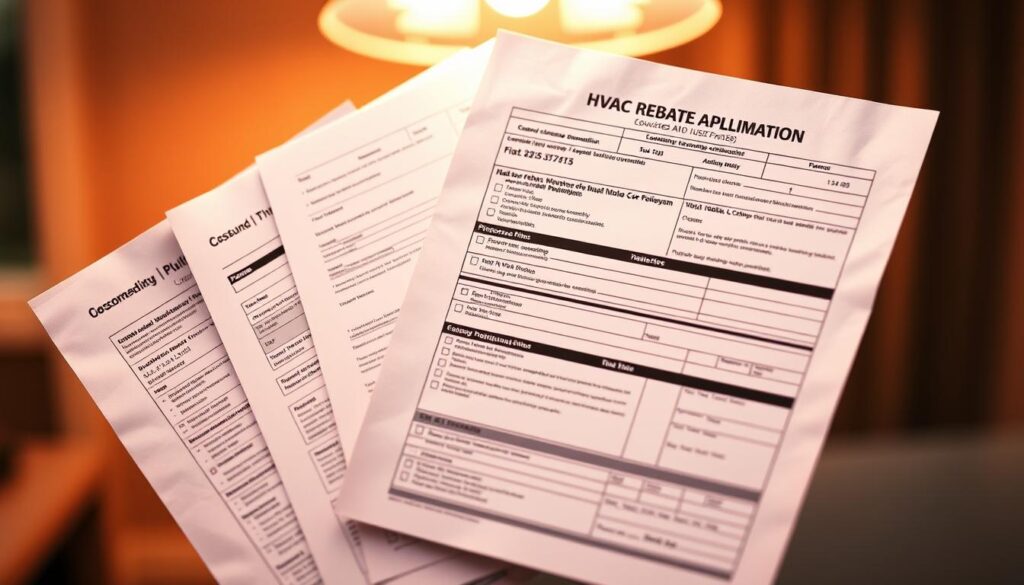Affiliate Disclosure
HVAC Guide Guys is a participant in the Amazon Services LLC Associates Program, an affiliate advertising program designed to provide a means for sites to earn advertising fees by advertising and linking to Amazon.
How to Apply for HVAC Rebate? Did you know upgrading your home’s HVAC system can save you hundreds or even thousands of dollars? Energy efficiency rebate programs make it possible. The process might seem complex, but with the right information, you can get big financial benefits for making your home more energy-efficient.

Figuring out how to apply for HVAC rebates can be tough. But this detailed guide will show you how to do it. You’ll learn about federal tax credits and local utility incentives. These can help lower the cost of making your home more energy-efficient.
If you’re thinking about replacing your old HVAC system or want to improve your home’s energy use, this guide is for you. Knowing about rebate opportunities can help you make smart choices. These choices will save you money and help the environment.
Key Takeaways
- Federal and state rebate programs offer substantial financial incentives
- Energy-efficient HVAC upgrades can significantly reduce utility costs
- Proper documentation is crucial for successful rebate applications
- Rebate amounts vary based on system efficiency and property type
- Professional HVAC contractors can help navigate rebate requirements
Table of Contents
Understanding HVAC Rebate Programs and Tax Credits
Exploring HVAC tax incentives can seem tricky. Yet, knowing about these programs can lead to big savings on energy-efficient home upgrades. Homeowners can cut down on costs and their carbon footprint through various rebates and incentives.
There are many financial incentives for energy-efficient home upgrades. These come from the federal, state, and local levels.
Federal Tax Credit Landscape
The federal government offers big tax credits for certain HVAC systems. These incentives aim to encourage homeowners to choose energy-efficient options:
- Credits can cover up to 30% of installation costs
- Applicable for high-efficiency heating and cooling systems
- Valid for primary residences
State and Utility Company Initiatives
States and utility companies have their own rebate programs. These can add to federal incentives. Your location can greatly affect the savings you can get.
| Program Type | Potential Savings | Eligibility |
|---|---|---|
| State Rebates | $200 – $1,500 | Varies by state |
| Utility Company Rebates | $50 – $800 | Customer-specific |
Energy Star Certification Requirements
Energy Star certification is key for most rebate programs. Not all HVAC systems qualify. To be eligible, your system must:
- Meet specific energy efficiency ratings
- Be installed by certified professionals
- Pass comprehensive performance tests
“Investing in Energy Star certified equipment is not just about savings, it’s about sustainable home improvement.” – Energy Efficiency Expert
To understand these programs, you need to do your homework. You might also want to talk to local HVAC experts. They can help you figure out what you need in your area.
Explore Our HVAC Shop
Looking for top-rated HVAC tools, parts, and accessories? Visit our shop and find the perfect solution for your needs.
Visit the ShopHow to Apply for HVAC Rebate: Step-by-Step Process
Applying for an HVAC rebate might seem hard, but it’s easier when you break it down. Your first step is to get ready and plan well.
Start by doing your homework. Look for rebate programs in your area. States and utility companies have different offers for energy-saving home upgrades.
- Verify Eligibility: Make sure you qualify for federal HVAC rebates. Your income, property type, and system efficiency matter.
- Gather Documentation: Collect your purchase proof, installation receipts, and system details.
- Select Certified Equipment: Choose an HVAC system that’s Energy Star certified.
- Complete Application Forms: Fill out all rebate forms correctly.
- Submit Supporting Evidence: Send in all needed documents with your application.
“Precision in your application can significantly increase your chances of receiving the maximum rebate possible.” – Energy Efficiency Expert
Online portals make applying for federal HVAC rebates easier. Many websites and utility companies let you apply online. This cuts down on paperwork and speeds up your rebate.
Pro tip: Always check your application before you send it. Mistakes can slow down or even stop your rebate.
Explore Our HVAC Shop
Looking for top-rated HVAC tools, parts, and accessories? Visit our shop and find the perfect solution for your needs.
Visit the ShopMaximum Rebate Amounts and Eligibility Criteria
Understanding state hvac rebate qualifications can be tricky. But knowing the key factors helps you get the most from home energy upgrade incentives. Each rebate program has its own rules, so it’s important to know what applies to you.
There are several important things that decide if you can get HVAC rebates:
- Household income levels
- Property type and ownership status
- System efficiency ratings
- Installation requirements
Income-Based Qualifications
Many rebate programs give more money to those with lower incomes. This is to help make energy-efficient upgrades more affordable.
Property Type Requirements
Rebate rules change based on the type of property:
- Primary residential homes
- Rental properties
- New construction projects
- Multi-family dwellings
System Efficiency Standards
To get rebates, your HVAC system must meet certain standards. Most programs look for:
- SEER rating of 15 or higher
- EER rating above 12.5
- HSPF rating of 8.5 for heat pumps
Always check with local utility providers and state energy offices for the latest on rebate qualifications for your situation.
Required Documentation for HVAC Rebates

Getting through the contractor rebate submission process can be tough. But, getting the right documents is crucial for your rebate. You need to show that you’ve upgraded your HVAC system and made it more energy-efficient.
When you’re filling out federal HVAC rebate forms, you’ll need a few important documents:
- Proof of purchase for your new HVAC system
- Detailed installation certificate from a certified contractor
- Manufacturer specifications for the installed equipment
- Energy efficiency ratings and performance documentation
- Proof of home ownership or occupancy
Your HVAC contractor is very important in this process. They know all about federal HVAC rebate forms and can help you get everything ready. They’ll give you the installation certificates and technical specs you need.
Here are some tips for getting your documents right:
- Keep all original receipts and invoices
- Ask your installer for detailed equipment performance documents
- Make sure your energy efficiency ratings meet the program’s needs
- Check all forms for mistakes before you send them in
Remember, bad or missing documents can mess up your rebate. Taking the time to get your paperwork in order will help you get the rebate you deserve.
Energy Efficient Home Improvement Tax Credit Details
Upgrading your home’s HVAC system can now be financially rewarding thanks to federal energy efficiency rebate programs. The Energy Efficient Home Improvement Tax Credit offers homeowners significant financial incentives for making energy-saving upgrades to their heating and cooling systems.
Credit Percentages and Financial Benefits
The tax credit allows you to claim a percentage of your HVAC system’s cost. This provides substantial savings on your tax bill. Homeowners can typically expect to receive:
- Up to 30% of the total installation cost
- Maximum credit of $2,000 for qualified heat pump systems
- Up to $600 for qualifying air conditioners and furnaces
Qualifying Equipment Types
Not all HVAC systems qualify for these hvac tax incentives. To be eligible, your equipment must meet specific energy efficiency standards:
- Heat pumps with HSPF ratings of 8.5 or higher
- Central air conditioners with SEER ratings of 16 or above
- Natural gas furnaces with AFUE ratings of 95% or greater
Installation Requirements
Claiming your energy efficiency rebate programs requires careful attention to installation details. Professional certification and proper documentation are crucial. You’ll need:
- Installation by certified HVAC technicians
- Detailed manufacturer receipts
- Energy efficiency certification documentation
“Investing in energy-efficient home improvements not only reduces your carbon footprint but can also provide substantial tax savings.” – Energy Star Expert
Explore Our HVAC Shop
Looking for top-rated HVAC tools, parts, and accessories? Visit our shop and find the perfect solution for your needs.
Visit the ShopTiming Your HVAC Rebate Application
Getting help with HVAC costs needs careful planning. The right time to apply for rebates can save you a lot. Knowing when to apply can help you get more savings and approval.
Important times to think about for your rebate application are:
- Fiscal year cycles of utility companies
- Seasonal program availability
- Budget allocation periods
- State and federal funding windows
Most rebate programs have set schedules. Utility companies update their offers at the start of their fiscal year or during certain seasons. Early preparation is crucial to grab these chances.
Smart ways to time your application:
- Look up program deadlines in your area
- Keep track of utility company funding cycles
- Watch for state and federal rebate news
- Apply during less busy times
Pro tip: Some rebate programs have limited funds. Quick action when new programs start can boost your approval chances and get you bigger rebates.
Timing is everything when it comes to energy efficiency incentives.
Stay updated by checking with local utilities, state energy offices, and trusted HVAC contractors. They know the latest on rebate opportunities.
Working with Qualified HVAC Contractors
Finding the right HVAC contractor is key for getting financial help with HVAC replacements. The right choice affects both the quality of the installation and the rebate process. Experts know how to handle rebate programs well, making your application smoother.
Contractor Certification Requirements
Not all contractors are the same when it comes to rebate applications. You should look for those with specific qualifications:
- Current HVAC certification from recognized industry organizations
- Proven experience with energy-efficient system installations
- Documented track record of successful rebate submissions
- Active licensing in your state
Documentation Support
A good contractor makes the rebate process easier by offering detailed support. They help with:
- Preparing detailed installation records
- Verifying equipment efficiency ratings
- Completing necessary rebate forms
- Tracking submission deadlines
Pro tip: Always ask about a contractor’s past rebate submissions before hiring them for your HVAC project.
Choosing a contractor who knows local rebate programs can save you time, money, and headaches.
Explore Our HVAC Shop
Looking for top-rated HVAC tools, parts, and accessories? Visit our shop and find the perfect solution for your needs.
Visit the ShopCommon Mistakes to Avoid in Rebate Applications

Applying for utility company rebates for HVAC systems can be tricky. Many homeowners make mistakes that can stop them from getting rebates. It’s important to know these common mistakes when applying for HVAC rebates.
Here are the most critical errors to avoid during your utility company rebate application:
- Incomplete Documentation: Not providing all needed paperwork can make your application invalid
- Submitting outdated or incorrect equipment specifications
- Missing critical application deadlines
- Neglecting to verify equipment energy efficiency ratings
- Skipping pre-approval steps for your HVAC rebate
Professional contractors suggest keeping detailed records during the rebate application process. Keep both digital and physical copies of all documents, including:
- Equipment purchase receipts
- Installation certificates
- Energy efficiency ratings
- Contractor certification documents
Your rebate application needs to be precise. Check every detail before you submit it. Even small mistakes can lead to rejection, costing you hundreds of dollars in potential rebates.
Pro Tip: Contact your local utility provider directly if you have any uncertainties about the application requirements.
By understanding and avoiding these common mistakes, you’ll have a better chance of getting HVAC rebates. This can help reduce your overall system investment.
Conclusion
Understanding energy star HVAC rebates can seem tough, but it’s doable. Knowing about federal tax credits, state programs, and utility offers helps a lot. This knowledge lets you make smart choices for your HVAC system upgrades.
Improving your home’s energy efficiency is more than just buying a new system. Keep detailed records, work with certified contractors, and stay updated on rebates. This way, you’ll get the most out of your investment. Energy-efficient systems save money and help the planet too.
Timing and preparation are key when applying for rebates. Look into local and federal programs, collect all needed documents, and follow the rules carefully. Each rebate has its own rules, so being patient and detailed is essential for getting the most help.
Start now by looking into the energy star HVAC rebates in your area. Being proactive can lead to big savings and a greener home.
FAQ
How do I know if I’m eligible for HVAC rebates?
What documents do I need to apply for an HVAC rebate?
How much money can I save through HVAC rebates?
How do I know if I’m eligible for HVAC rebates?
What documents do I need to apply for an HVAC rebate?
How much money can I save through HVAC rebates?
FAQ
How do I know if I’m eligible for HVAC rebates?
To see if you qualify, check your income, property type, and the new HVAC system’s energy efficiency. You need to meet certain criteria from federal, state, and utility programs. This includes buying Energy Star certified equipment and having it installed by a qualified contractor.
What documents do I need to apply for an HVAC rebate?
You’ll need proof of purchase, an installation certificate, and manufacturer specs. Also, your equipment model numbers, energy efficiency ratings, and sometimes an energy audit report. Your contractor can help gather these important documents.
How much money can I save through HVAC rebates?
Savings vary. You might get tax credits up to ,000 for heat pumps. Plus, state and utility rebates can add up to
FAQ
How do I know if I’m eligible for HVAC rebates?
To see if you qualify, check your income, property type, and the new HVAC system’s energy efficiency. You need to meet certain criteria from federal, state, and utility programs. This includes buying Energy Star certified equipment and having it installed by a qualified contractor.
What documents do I need to apply for an HVAC rebate?
You’ll need proof of purchase, an installation certificate, and manufacturer specs. Also, your equipment model numbers, energy efficiency ratings, and sometimes an energy audit report. Your contractor can help gather these important documents.
How much money can I save through HVAC rebates?
Savings vary. You might get tax credits up to $2,000 for heat pumps. Plus, state and utility rebates can add up to $1,500. The exact savings depend on the system’s efficiency and the rebate program.
How long does the HVAC rebate application process take?
Processing times differ. Federal tax credits are claimed when filing taxes. Utility rebates might take 4-8 weeks. Apply as soon as you can after installation and keep all documents safe.
Can I get rebates for replacing an existing HVAC system?
Yes, most programs help replace old systems with new, efficient ones. Make sure the new system meets Energy Star standards and the program’s requirements.
Do I need a professional contractor to apply for rebates?
While not required, a certified contractor is recommended. They know the rebate rules, help with paperwork, and ensure your installation meets standards.
Are there different rebates for different types of HVAC systems?
Yes, rebates vary by system type. Heat pumps often get the biggest incentives because they’re very energy-efficient.
What are the most common mistakes in rebate applications?
Mistakes include missing documents, late applications, and not meeting efficiency standards. Always check requirements and work with a knowledgeable contractor.
Can I combine federal tax credits with state and utility rebates?
Often, yes. You can stack federal tax credits with state and utility rebates. But, each program has its own rules, so research carefully.
How do I find rebate programs in my area?
Check the Database of State Incentives for Renewables & Efficiency (DSIRE), your utility company’s website, and Energy Star’s rebate finder. Your HVAC contractor can also guide you on local incentives.
,500. The exact savings depend on the system’s efficiency and the rebate program.
How long does the HVAC rebate application process take?
Processing times differ. Federal tax credits are claimed when filing taxes. Utility rebates might take 4-8 weeks. Apply as soon as you can after installation and keep all documents safe.
Can I get rebates for replacing an existing HVAC system?
Yes, most programs help replace old systems with new, efficient ones. Make sure the new system meets Energy Star standards and the program’s requirements.
Do I need a professional contractor to apply for rebates?
While not required, a certified contractor is recommended. They know the rebate rules, help with paperwork, and ensure your installation meets standards.
Are there different rebates for different types of HVAC systems?
Yes, rebates vary by system type. Heat pumps often get the biggest incentives because they’re very energy-efficient.
What are the most common mistakes in rebate applications?
Mistakes include missing documents, late applications, and not meeting efficiency standards. Always check requirements and work with a knowledgeable contractor.
Can I combine federal tax credits with state and utility rebates?
Often, yes. You can stack federal tax credits with state and utility rebates. But, each program has its own rules, so research carefully.
How do I find rebate programs in my area?
Check the Database of State Incentives for Renewables & Efficiency (DSIRE), your utility company’s website, and Energy Star’s rebate finder. Your HVAC contractor can also guide you on local incentives.

